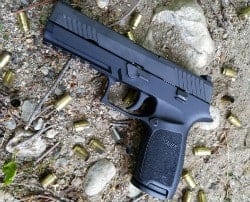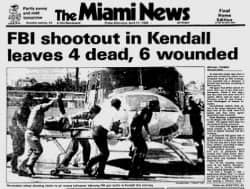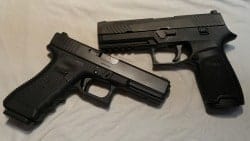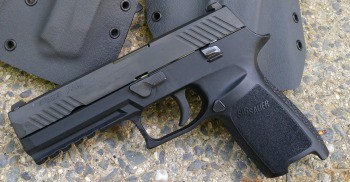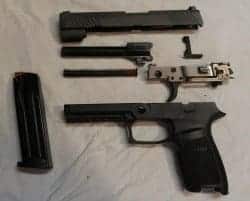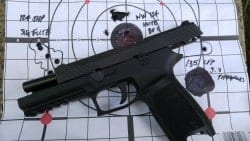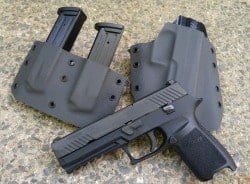So I got a Sig Sauer P320. I saw it in a local pawn shop, sitting there in the glass case, perched on green velvet,
You see, I grew up in a transitional period in firearms development. In the late 1970’s and early 1980s, police
In the Miami shootout, FBI agents went up against two combat-hardened military veterans who had some serious armament – a semi-auto 12-gauge shotgun, a Ruger Mini-14 with multiple 30-round magazines, and several handguns. To counter this, eight FBI agents fielded just two 12 gauge shotguns loaded with buckshot, and mostly revolvers – though two agents had Smith 459s in 9mm with Winchester Silver tip ammo. Although the two suspects were neutralized eventually, they wounded or killed all but one of the eight FBI agents who engaged them. One agent named McNeill suffered one of the worst fates possible in a gunfight: he was shot in the hand by one of the suspects, and when his revolver ran dry, he could not reload due to blood and gore in the gun, and his injuries. He was then shot in the head and neck and though he survived, he was left paralyzed for some time.
I remember my father talking about the gunfight when it occurred, and reading about it in gun magazines – notably
Related: Sig Sauer P227 Nitron Review
I also remember hearing my father complain about the flood of “those damn plastic pistols”, and he clung to his Smith & Wesson revolvers tightly (he only started to begrudgingly accept “tupperware” Glocks in the past couple years – and he refuses to try any other polymer framed pistols!) His grousing led to permanent impressions being left in my young brain, and to this day, I have a tough time embracing modern, polymer-framed, striker fired handguns.
SKIP AHEAD
Back To The Sig
To bring this around full circle: Glock’s striker-fired monopoly on the handgun market was definitely noticed by all
However, one of the premier firearms manufacturers in the world were strangely silent: Sig Sauer, a German company that has a huge manufacturing facility and new headquarters in New Hampshire, USA, never said “peep” about making a “Glockfighter” handgun. Maybe it was because they’d always made expensive, high-end DA/SA handguns; they didn’t want to undercut their niche. However, you could see that maybe they were testing the waters on lower-cost handguns: The SP2022 was a polymer-framed evolution of the 226/228/229 family, and the P250 was an innovative hammer-fired handgun that used a stainless steel fire control group chassis that could be interchanged into inexpensive grip modules. All of these were well-received as being high-quality handguns worthy of the Sig brand, but they weren’t what the world wanted. But then, in January 2014, Sig unveiled their new P320 to the world and promptly dropped the mike. BOOM.
For the past few years, Sig had quietly been watching and researching. They wanted to address the major shortfalls of the early striker-fired genre (we’re looking squarely at you here, Glock): terrible out-of-the-box trigger pulls, blocky grip frames, glaring lack of ambidextrous controls. Sig had been waiting in the wings, interviewing veteran military and police officers to get their take on what makes a good handgun great, to make sure their offering was just right…and it was worth the wait.
Also Read: Smith & Wesson M&P 40C Review
Sig Sauer wasn’t content with having tacky add-ons for existing designs to address issues – the Glock Gen 4’s feeble attempt at fitting differently-sized hands with add-on backstraps being a good example. They wanted a full-tilt modular pistol, and that’s what they rolled out. The P320 isn’t just a great, reliable design that shoots well; it is a masterpiece, a platform of unequaled modularity. You see, the P320’s design is centered around a central stainless steel fire control group chassis. This small chassis is serial numbered, and is considered the firearm. As a consequence, the owner of the pistol can completely swap out the rest of the gun…the grip module can be swapped out to full sized, carry (full sized grip length with a shorter railed dust cover for a shorter slide), compact, and subcompact sized frames. Each of these sizes of frames are also available in large, medium, and small grip frame girths to accommodate almost all sizes of shooter hands. Likewise, the slide, barrel, and recoil spring assemblies can be swapped out as well; Sig offers multiple lengths for these as well. Want a different caliber pistol? No sweat! The 9mm, .40 S&W, and .357 Sig barrels and magazines all drop into the same grip/slide assemblies. Sig offers “X-Change” kits that let you select the configuration/length/caliber you’d like, and buy them all in one shot.
This all ensures that you can have the pistol you want, in the caliber you want, in the configuration you want, tailored to fit your hand. This sort of modularity is a game-changer, and leaves all the other manufacturers with pin-on grip adapters and change-out backstraps way back in the dust. It also ensures that the military is certainly considering it deeply in their new MHS (Modular Handgun System) platform competition, and it cinched the American Rifleman Golden Bullseye Award for the 2016 Pistol of the Year.
The Nitty-Gritty
Let’s take a look at what all this modularity specifically brings to the table, as well as some other great stuff the P320 offers. There are four basic platform sizes available for the P320, each of them with three different grip sizes: small, medium, large. The platforms are:
P320 Full-sized: 8.0” overall length, 5.5” overall height. The Full-sized configuration sports a 4.7” long barrel, and a 17-round magazine in 9mm. Weighs 29.4 ounces with the magazine in it, unloaded. Five slots on the dust cover accessory rail, to mount lights, lasers, etc.
P320 Carry: Same grip frame as the Full-sized with 17-round 9mm magazines, but with a shorter 7.2” overall length and 3.9” barrel and 26.0 ounce weight unloaded. Shorter dust cover, four slots in the accessory rail.
P320 Compact: The Compact has the shorter 7.2” overall length of the P320 Carry, but utilizes a grip that is a tad shorter, at 5.3” high. 25.8 ounces unloaded. The magazine capacity is reduced to 15 round in 9mm due to the shorter grip. Four slots in the accessory rail.
P320 Subcompact: The Subcompact model pares away everything not needed, and enjoys a small 6.7” overall length and 4.7” overall height to enhance concealability. 24.9 ounces unloaded. The 9mm version carries only (!) 12 rounds in the magazine. The subcompact also has sleeker lines, eliminates the accessory rails, and sports a rounded, no-snag triggerguard in place of the familiar square, hooked Sig Sauer triggerguard.
Okay, so there are four basic pistol offerings. That’s all well and good. But a really cool thing about the P320’s design is that you can, to a reasonable degree, mix-and-match frames and barrels. You don’t have to stick to the Sig standard factory-offered configurations. For example: you can buy a full-sized P320 like mine. Then, for about $45, you can purchase a P320 Compact grip and mount your full-sized slide and barrel to it. I’ve seen lots of cool builds online from P320 owners making custom configurations out of their guns, even to the point of people cutting off sections of grip frame to make offball configurations like a full-sized slide that sits on a subcompact frame. And before you ask, yes – the full-sized mags all fit and function in the smaller grip frames. All of the sizes are available in 9mm, .40 S&W, .357 Sig, and .45ACP. Caliber X-change kits are $399 from the Sig Sauer online store – however, I’ve seen them sold privately and locally for less than that. I don’t believe the .45ACP components will marry with the smaller-caliber components due to case size – but I don’t have one to test, so I can only surmise.
Also Read: Rothco Concealed Carry Jacket Review
The glass-reinforced polymer grip frames all have nice grippy texture on them – likely a response to many polymer framed gun owners sending their guns out be stippled or have grip texture enhancements. The triangular shaped Browning-style magazine release is reversible for southpaws, and the small black steel slide catch is 100% ambidextrous with catches on both sides of the gun. Looking at the grip, you’ll notice the pistol has an odd profile at the magazine well at first glance. However, once you realize that it’s notched to enable the user to grasp the magazine baseplate for a good hearty magazine rip-out in an emergency, you wonder why other guns don’t have similar features. A lanyard hole in the back of the grip is standard – a slick offering for people who appreciate the retention possibilities of a good lanyard. The only other control on the frame is the takedown lever, which is on the left side of the gun. Mine is an earlier generation gun and as such, the takedown lever is slightly stepped and contoured. Newer model takedown levers are flat to the frame – however, I really like the tapered design of mine, since it provides a bit of a natural thumb rest for the off-hand thumb in a modern thumbs-forward shooting hold.
The slides are matte black Nitron coated, and are beveled and contoured to keep weight down and allow the gun to be re-inserted into holsters more smoothly. Sig is offering standard on the P320 what is an expensive custom detail on other pistols: forward slide serrations in addition to the standard serrations at the rear of the slide. These forward serrations are a godsend when doing press-checks to see if there is a round in the chamber, and all the serrations are deep, wide, and very positive to utilize. Really a great feature of this gun. Also of note: every P320 I’ve ever seen comes with SigLite night sights. I’m told they come with Sig 3-dot standard contrast sights, but I have yet to see them. So chances are you’ll find one with night sights installed– and they’re right about the same price as a Glock without night sights. Just sayin’…I was at the local Cabela’s last night, and a brand new P320 with night sights was $599. A new Glock 17 without night sights was $549.
Related: Survival Carbine
The stainless steel Fire Control Unit (FCU) is the heart of the whole gun. It encompasses the trigger, frame rails, ejector, and all the necessary safeties and guts that make the gun work. The FCU sits in the top of the grip frame, and runs from just forward of the takedown lever, back to the rear of the frame. Removing and reinstalling it is a breeze, and a tip of the hat is required to the engineers who designed it. The FCU, as stated previously, has the serial number stamped on it, which shows through a window that is moulded into the right hand size of the frame. It’s an ingenious setup, one that I bet will be imitated by others in the future.
As a side note: The Sig P320 and P250 platform are brothers – the P320 is striker-fired, while the P250 is double-action-only hammer fired. As such, magazines and grip frames are interchangeable between the two guns. A nice little tidbit to know while looking for accessories such as holsters.
First Impressions
The first time you pick up a P320 Full Size, you immediately think, “Geez, that’s BIG”. And it kind of is big, but much of it is due (in my eyes) to the deep, long, blocky dust cover that runs from the triggerguard all the way to the end of the 4.7” barrel; it makes the gun seem taller than most other handguns. But the grip is long as well, made to house a magazine that holds 17 9mm rounds or 14 .40 S&W/.357 Sig cartridges. The overall size is probably close to a Beretta 92/M9, though not quite as long. The Sig feels much more svelte than the M9, though, and points better in my hand, feels more intuitive. When making the obvious comparison to a Glock 17, the P320 is indeed bigger, but not by much…and the P320 grip feels like it was made for your hand when comparing it to the made-out-of-Legos feeling Glock grip. The contours, the balance, the reach to the controls – all are very well thought out and executed on the P320. And then you get to the trigger.
Also Read: Magpul Armorer’s Wrench Review
Oh, the trigger! The trigger on the P320 was the deal breaker that sold me on the gun. Sig obviously directed a LOT of time and effort into getting this aspect of the pistol right. And if you’ve shot a box-stock Glock or M&P, you know why: the factory triggers of most striker fired pistols are just plain awful. They have a ton of takeup and creep, and the sear letoffs are gritty and mushy. It’s understandable, though: There are many internal levers, safeties, draw bars, strikers, and interfacing parts that need to move, slide, drop, and actuate in concert to allow the gun to fire. And while all of those parts do a wonderful job of ensuring that the guns will not fire until the triggers are fully pulled to the rear, they also ensure that the trigger pulls are less than stellar.
This can all be addressed with aftermarket parts, for sure: Ghost and others make great drop in springs and disconnectors for Glocks, and Apex’s Action Enhancement Kits are wonderful treatments for ailing M&P triggers. But the P320? Well, it has a wonderful trigger, straight from the factory. It’s not “tuned 1911” perfect, but the trigger is definitely head and shoulders above the similarly-priced competition. There is a slight takeup, maybe 1/4” of travel, but then the trigger breaks cleanly and crisply after about 7 pounds of pressure. However, the pull seems lighter than the advertised 7+/- pounds due to the exceptional action and clean break. Apex and others are starting to make aftermarket triggers and other goodies for the P320, but I simply haven’t felt the need. The trigger is superb for a striker fired gun, straight from Sig. If it ain’t broke…
Also Read: Firearm Maintenance When The SHTF
The rest of the gun on first inspection just exudes Sig quality. The finish is beautiful, hard-wearing and even, the sights are well-defined and highly visible, and all the controls feel solid and look good. The only thing close to chintzy in the whole setup isn’t even the gun – the P320 comes with an almost-an-afterthought paddle-type plastic holster. It’s nice that Sig made a holster available to the owner upon purchase, and the holster works okay – it holds the gun on your hip, the triggerguard is covered, the pistol is reasonably secure. But the moulded plastic is kind of cheap, the design is blocky and it doesn’t hug the body. I’ll admit I used it, but only until my GunfightersINC Ronin OWB kydex holster came in the mail. After that, the stock Sig offering went into the dusty black-hole bin of forgotten holsters. Honestly, I would have rather paid $15 less on the overall price and not had the holster come with the pistol. But that’s my call; the included holster is a nice thought for the run-of-the-mill pistol owner who goes out the range with his buddies three times a year. But, for serious usage and hard duty, spend the money and get a good holster.
Breaking It All Down
Taking the P320 apart into its key components is a breeze. Sig also incorporated a safety feature into the P320’s
To disassemble, clear the gun. Make sure it’s empty. Then do it again. Drop the magazine out of the pistol if you haven’t already, then lock the slide ito the rear. Rotate the takedown lever just over 90° clockwise, until it stops. Then, controlling the spring tension the slide is under, release the slide by pushing the slide stop down or pulling slightly back on the slide, allowing the slide stop to drop out of its engagement catch. Let the slide ride forward and off the frame. The recoil spring assembly and the barrel can then be removed out of the bottom of the slide, just like most other semi-auto pistols. The pistol is now essentially field-stripped for cleaning.
However, to clean the FCU or to change grip modules, you simply take the field-stripped grip frame, grasp the takedown lever, and give it a pull while rotating it slightly back and forth, removing it from the frame. Then, hook your finger under the front of the FCU, and pull it up and out. That’s it. The whole process is brutally simple and easy. The FCU can then be cleaned up, or placed in a new grip module if you so desire. Re-assemble in reverse order. That’s it, folks. It likely took you longer to read this paragraph than it would to disassemble a P320 down to its key components of slide, barrel, recoil assembly, takedown lever, FCU, magazine, and grip frame. The simplicity and modularity is breathtaking, and worth every penny of the price of admission.
Shooting The P320
I’ll admit, it took me a bit longer that I would’ve liked to find my “groove” and get familiar with this pistol to the
When I first got the pistol, the pistol was hitting high. Way high. Like 8 inches higher than point of aim at 15 yards. I tried different bullet weights – 115s, 124s, and 147s – and they all shot similarly high. I then jumped on my laptop, took a deep breath, and waded through the mall ninja dribble online. A bit of internet research eventually informed me that this point of impact issue is a common problem with the P320s with the 8/8 sights. Sig Sauer numbers their sight heights to denote levels of impact – the higher the number on the sights, the higher the point of impact. I had these sights – #8 front, #8 rear. I contacted Sig Sauer, explained my problem, what I’d done to make sure it wasn’t me, and sent pictures of the groups in. Three days later, I had a new #6 SigLite front sight in my mailbox. How’s that for customer service?
I installed the new front sight, and the point of impact came right down. It’s still slightly high, maybe 1 ½ inches high from point of aim at 15 yards, but now it’s usable, and I’ve gotten used to it. I now cut the target in half with my front sight, and if I do my part, the pistol rewards me with solid hits time and time again.
I really wanted to use this Full-Sized 9mm P320 as a steel plate match and IDPA gun. To shoot lots of matches on a budget requires reloading ammunition, so I took the plunge. I purchased 2,000 124-grain lead round nose bullets and several different powders that friends had recommended for 9mm loads. However, I’m finding that even after trying several different handload combinations, 4”-6” groups are the norm at 15 yards. I’m planning on trying other powders and other bullets, but I have yet to find a 124-grain lead bullet load the pistol likes. To Sig’s merit, there are many people running P320s as match guns with several of the loads I tried, resulting in excellent accuracy. Mine just doesn’t like the handloads I’ve tried so far.
However, factory ammunition is a different story altogether. My pistol dearly loves Winchester “white box” 115-grain full metal jacket ammuntion, and routinely shoots ragged one-hole two-inch 10-shot groups with it. It also shoots Sig Sauer’s Elite V-Crown 124-grain JHP ammunition superbly, so that is the defense load I carry in the pistol. PMC Bronze 115 grain FMJ ammunition and Federal American Eagle 147-grain FMJ both shoot very well out of the pistol. I rested the gun on a shooting bench, and was rewarded with a 20-yard, 10-shot group with Winchester 115-grain FMJ measuring just under two inches. The Sig Elite V-Crown 124s performed similarly. That’s excellent accuracy for an out-of-the-box pistol…I’m pretty sure that with ammunition it likes, this pistol will shoot better than I can. Functioning over probably 750 rounds so far – mostly dirty, lead-bullet handloads – has been absolutely flawless. You can’t ask for more than that, friends.
Wrapping It Up
In conclusion, it’s definitely telling that Sig Sauer took their time and made an outstanding offering straight out of
Related: SHTF Grab ‘N’ Go Pistol Bag
The P320 platform, on a whole, makes an excellent choice for the person who needs multiple roles in their pistols (full sized “belt” gun, concealed carry gun, plinker, training firearm, home defense, etc.) but can’t afford multiple pistols or doesn’t want the maintenance or liability hassles that owning many guns can bring. If Sig Sauer would follow suit with many of their other handgun designs and offer .22LR conversion kits (you hear me out there, Sig??) you could truly have a damn-close-to-perfect-do-it-all handgun.
Do me a favor, especially if you already own a polymer-framed striker-fired handgun. Next time you see a Sig Sauer P320 in a gun shop’s case, ask to handle the gun. Ask to dry-fire it. Ask to try out or be shown the disassembly feature, and how the modularity comes into play. I bet you’ll be impressed; maybe even impressed enough to look sideways at other striker-fired guns, give in to the dark side like I did, and buy a P320. Trust me, it was worth the wait.
Photos By:
Drew
Panteao Productions
The Miami News


